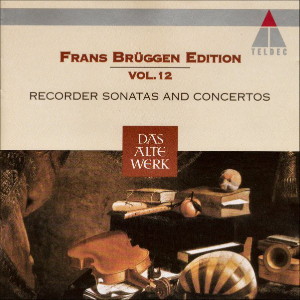 |
|
1 CD -
4509-97474-2 - (c) 1995
|
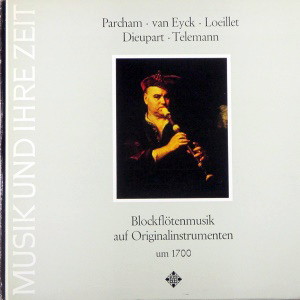
|
| 1 LP -
SAWT 9482-A - (p) 1966 |
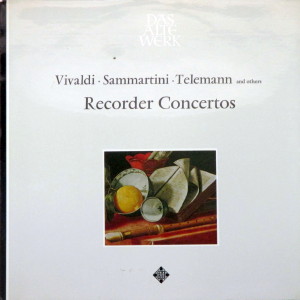 |
| 1 LP -
SAWT 9533-B - (p) 1968 |
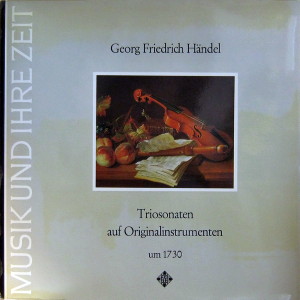 |
| 1 LP -
SAWT 9559-A - (p) 1970 |
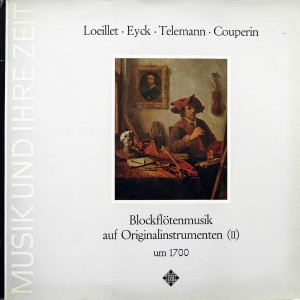 |
| 1 LP -
SAWT 9545-A - (p) 1969 |
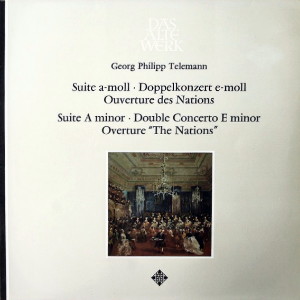 |
| 1 LP -
SAWT 9413-B - (p) 1962 |
|
| FRANS
BRÜGGEN EDITION - Volume 12 |
|
|
|
|
|
RECORDER SONATAS AND CONCERTOS
|
|
|
|
|
|
| Jean Baptiste Loeillet
(1688-1720) |
|
|
| Sonata in C minor
- treble recorder and basso continuo |
7' 51" |
|
| 1.
Adagio |
2'
23" |
|
2.
Vivace
|
1'
49" |
|
| 3.
Largo |
1'
54" |
|
4.
Allegro
|
1'
45" |
|
|
|
|
| Giuseppe Sammartini
(1695-1750) |
|
|
| Concerto
in F major - fifth flute [in
c"], strings and basso continuo |
13' 39" |
|
| 5.
Allegro |
4'
31" |
|
6.
[Siciliano]
|
5'
00" |
|
7.
Allegro assai
|
4'
08" |
|
|
|
|
| George Friderich Handel
(1685-1759) |
|
|
Trio
Sonata in B minor TWV 386b -
transverse flute, violin and basso
continuo
|
11' 38" |
|
| 8. Andante
|
4'
11" |
|
| 9. Adagio ma non
troppo |
2'
26" |
|
10. Largo
|
2'
53" |
|
| 11. Allegro |
2'
08" |
|
|
|
|
| Jacques-Christophe
Naudot (c.1690-1762) |
|
|
| Concerto
in G minor (from: "Six
Concertos em quatre parties..."
op. 17, Paris 1742 - treble
recorder, two violins and basso
continuo |
10' 27" |
|
12. Allegro
|
4'
30" |
|
| 13. Adagio |
3'
02" |
|
| 14. Allegro |
2'
57" |
|
|
|
|
Jean Baptiste Loeillet
|
|
|
| Sonata
in G major - treble recorder
and basso continuo |
10' 55" |
|
| 15. Largo |
2'
40" |
|
| 16. Allegro |
2'
11" |
|
| 17. Adagio |
3'
14" |
|
| 18. Gavotta |
2'
50" |
|
|
|
|
| Georg Philipp Telemann
(168-1767) |
|
|
| Concerto
in E minor - treble recorder,
transverse flute, strings and basso
continuo |
13' 38" |
|
| 19. Largo |
3'
38" |
|
| 20. Allegro |
4'
06" |
|
| 21. Largo |
3'
17" |
|
| 22. Presto |
2'
37" |
|
|
|
|
Frans Brüggen, recorder,
transverse flute (8-11)
|
The Chamber
Orchestra of Amsterdam (19-22) |
|
| Nikolaus Harnoncourt, viol
(1-4), violoncello (8-11) |
- Franz Vester,
transverse flute (19-22) |
|
| Alice Harnoncourt, violin
(8-11) |
- André Rieu,
direction (19-22) |
|
| Herbert Tachezi, harpsichord
(8-11) |
Concentus musicus
Wien (5-7, 12-14) |
|
| Gustav Leonhardt, harpsichord
(1-4, 15-18) |
|
|
| Anner Bylsma, violoncello
(15-18) |
|
|
|
|
|
|
Luogo
e data di registrazione |
|
-
Palais Schwarzenberg, Vienna
(Austria) - novembre 1965 [1-4]
- Casino Zögernitz, Vienna
(Austria) - 27 & 28 febbraio
1968 [5-7, 12-14]
- Vienna (Austria) - settembre
1969 [8-11]
- Bennebroek (Olanda) - aprile e
maggio 1969 [15-18]
- Data e luogo di registrazione
non riportati [19-22]
|
|
|
Registrazione:
live / studio |
|
studio |
|
|
Producer /
Engineer |
|
Wolf
Erichson [8-11, 15-18]
|
|
|
Prima Edizione
LP |
|
-
Telefunken "Das Alte Werk" - SAWT
9482-A - (1 LP) - durata 52' 16" -
(p) 1966 - Analogico [1-4]
- Telefunken "Das Alte Werk" -
SAWT 9559-A - (1 LP) - durata 49'
51" - (p) 1968 - Analogico [5-7,
12-14]
- Telefunken "Das Alte Werk" -
SAWT 9559-A - (1 LP) - durata 44'
21" - (p) 1970 - Analogico [8-11]
- Telefunken "Das Alte Werk" -
SAWT 9545-A - (1 LP) - durata 41'
45" - (p) 1969 - Analogico [15-18]
- Telefunken "Das Alte Werk" -
SAWT 9413-B - (1 LP) - durata 54'
05" - (p) 1962 - Analogico [19-22]
|
|
|
Edizione CD |
|
Teldec
- 4509-97474-2 - (1 CD) - durata
68' 46" - (c) 1995 - ADD |
|
|
Note |
|
- |
|
|
|
|
The Flemish
composer Jean
Baptiste Loeillet spent the
greater part of his active
life in France in the
service of the Archbishop of
Lyons. Although it may well
be the case that the
mannered style of music
cultivated in early
18th-century Paris had yet
to reach the French
provinces, it is equally
likely that Loeillet was
familiar with this style and
that he chose to ignore it.
At all events, his 48
sonatas for treble recorder
and continuo reveal a
connoisseur and champion of
the Italianate
cantabile style. From Italy
too, he took over the form
of the sonata da chiesa,
while at the same time
breaking it down by
occasionally introducing a
dance movement, as in the G
major Sonata. In the slow
movements, the solo voices
melodic line unfolds in
beautifully arching
paragraphs, while the fast
movements are witty and
playful. The C minor Sonata
strikes a darker note,
especially in the first and
third movements.
Giuseppe Sammartini’s
F major Concerto is one of
only a handful of original
compositions for descant
recorder and, of all the
concertos written for this
instrument (one thinks
especially of pieces by
Babell, Baston and
Woodcock), certainly
deserves pride of place.
Sammartini was born in
Milan, but moved to London
around 1728 and quickly made
a name for himself as an
oboist, in which capacity he
also played in Handel's
orchestra. In 1776 the
English writer on music Sir
John
Hawkins called him “the
greatest oboist that the
world had ever known".
Formally speaking, the F
major Concerto is closely
related to its Vivaldian
prototype, albeit with a
less rigid distinction
between tutti and solo. The
middle movement is
particularly impressive,
with the widely arching
melodic lines of the solo
voice allowing the modern
listener to gain an
impression of Sammartini’s
phenomenal breath control.
The Trio Sonata in B minor
HWV 386b
by George Frideric Handel
was published around 1752
and is based on an earlier
version that may date back
to 1718 or thereabouts. The
work is written in the stile
misto, a mixture of
French elements such as
short-bowed motifs and
dotted rhythms in the first
two movements and, in the
third movement, an Italianate
“aria” for the flute
accompanied by double-stopping
on the violin.
“Monsieur Naudot” was the
name by which the composer Jacques-Christophe
Naudot announced himself to
the world on the title-pages
of all the works that he
published in Paris between
1726 and 1752. For his op. 17
collection (from which the
present concerto is taken)
he suggested as solo
instrument not only the
recorder but also the vielle
(or hurdy-gurdy, on which
Naudot himself was
proficient) and musette (a
small bagpipe). Such were
the technical limitations of
these two instruments that
the soloist rarely appears
on his own but is generally
accompanied by the first
violin, a circumstance that
has implications for the
style of the work as a
whole. Its title
notwithstanding, this is no
Italianate
concerto with clearly
contrasted solo and tutti
but a French-style concert
of chamber-like intimacy, an
intimacy enhanced in the
present recording by
assigning the violin lines
to individual players.
By the first half of
the 18th century the treble
recorder was slowly being
displaced by a new star in
the musical firmament in the
form of the transverse
flute, which had begun its
triumphant conquest of the
musical scene around the
beginning of the century
with the result that few composers
chose to combine the two
instruments within a single
work. By far the greatest of
these pieces is Georg
Philipp Telemann's
Double Concerto for treble
recorder flute, strings and
continuo, a work in which
the composer gives the two
solo instruments ample
opportunity to show
themselves off to advantage,
with the clear, almost
austere sounds of the
higher-pitched recorder
contrasted with the flutes
more velvety tone. Both
instruments vie with one
another in the high-spirited
episodes of the final
Presto, a rondo
characterised by folklike
elements of a kind possibly
assimilated by Telemann
during his time in Poland. In
his autobiography of 1739,
he writes: “It is
hard to credit the wonderful
ideas that occur to such
recorder players and
violinists.
[...] An
attentive person could pick
up enough ideas from them in
eight days to last him an
entire lifetime.”
Martin
Nitz
·····
A brief
history of the
recorder
12.
The recorder in the
20th century
Frans Brüggen
(II)
Having persuaded Martin
Skowroneck to make two
copies of early recorders in
1966, Frans Brüggen
set about attempting to
recapture the lost sound-world
of the Baroque recorder. His
overriding concern was to
gain a better under standing
of, and feeling for,
18th-century works by
playing on instruments as
close to the originals as
possible. To this end, he
encouraged recorder makers
to produce accurate copies
of early instruments, a
process in which they were
able to benefit from Brüggen's
expertise. Skowroneck’s
pioneering efforts were
followed by Hans Coolsma’s
copies of a treble recorder
by Bressan and a Baroque
flute by Stanesby. They were
shortly joined by Friedrich
von Huene and Fred Morgan,
and soon there was a
veritable army of instrument
makers producing recorders
and, later, flutes, oboes
and other wind instruments
on the basis of period
models. Parallel with this
development, Brüggen
began collecting the finest
period recorders and flutes
that he could find.
In the meantime, he had
begun working for TELDEC,
recording many releases on
period instruments or on
copies of them. In
this way he made recordings
on some 30
or so 18th-century
instruments. Many of these
recordings won international
awards such as the Edison
Prize, the Deutscher
Schallplattenpreis, the
Premio della Critica
Discografica Italiana and
the Grand Prix du Disque. Brüggen
systematically committed to
disc all the most important
recorder repertory,
including many works not
previously heard in the 20th
century. Among the pieces he
recorded on the most
appropriate period
instruments were sonatas and
concertos
by Telemann, Babell,
Scarlatti, Handel and
Dieupart. Of particular
importance in this context
was his work with Gustav
Leonhardt, Anner Bylsma and
Nikolaus Hamoncourt.
Between around 1965 and 1980
Brüggen
was unquestionably the most
successful recorder player
on the international musical
scene. For TELDEC he
recorded more than 100 works
for recorder and for both
the Baroque and modern
flute, in addition to
appearing as a conductor, an
activity he took up in the
1960s with Telemann's Tafelmusik.
At this time, he was also
giving some 100
international concerts
annually as well as editing
often unknown works for the
recorder collaborating with
recorder makers such as Hans
Coolsma and, later, Fred
Morgan and, last but not
least, fulfilling his
teaching commitments. As a
teacher Frans Brüggen
exerted a decisive influence
on the performing practice
of early and new music in
general and of the recorder
in particular. His
appointments at colleges of
music and universities from
The Hague to Amsterdam and
from Harvard to Berkeley
helped to mould a whole
generation of musicians and
recorder players who, in
turn, have produced a new
generation of their own. In
this way Brüggen's
influence as a recorder
player continues to be
widely felt.
Frans Brüggen's
recorder playing is
distinguished by its great
originality, combined with
his immense personal
charisma and absolutely
flawless technique Die
Welt
has described him as
“utterly lacking in vanity
and committed to music
alone”, while Gramophone
has called his playing "ultimate
perfection". After giving
up teaching in the early
1970s (“after a certain
moment one has had enough.
Through teaching one
unconsciously lowers ones
own standards. I wanted to
be involved only with
grand masters”),
Brüggen
gradually reduced the
number of his recorder
concerts.
In 1981 Frans Brüggen
founded the Orchestra of
the 18th Century an
international orchestra
made up of period-instrument
specialists. The players
meet two or three times a
year to perform and record
a repertory extending from
Rameau
to Beethoven, Schubert and
Mendelssohn. Today Frans
Brüggen
may also be heard
conducting modern
orchestras all over the
world.
Fortunately his past
activities as a recorder
player can still be
relived through his many
recordings for TELDEC.
Peter
Holtslag
Translation:
Stewart Spencer
|
|